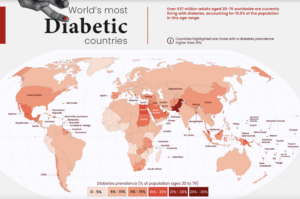July 22nd, 2023
Looking at the Visual Capitalist’s diabetes rates by country in 2021, a worrying trend quickly becomes clear: developing countries such as Pakistan, Egypt, Mexico, and the Pacific Island states are facing significant challenges ahead:
Mapping Diabetes Rates by Country in 2021
Despite advancements in healthcare lengthening life expectancy across the world, there are still many diseases that are hard to beat. One of these growing and costly diseases is diabetes, but each country is being hit differently.
One of the leading causes of death and disability globally, over half a billion people are living with diabetes today. The World Bank’s IDF Diabetes Atlas reveals that diabetes was responsible for 6.7 million deaths in 2021 alone.
In this graphic, Alberto Rojo Moro uses this World Bank Atlas to map diabetes rates by country, highlighting the countries with the highest rates of the disease.
What is Diabetes?
Diabetes (also known as diabetes mellitusis) a long-lasting condition that affects how the body turns food into energy.
Normally, our bodies break down the food we consume into glucose (a sugar) and release it into our blood. When our level of blood sugar rises, insulin produced by our pancreas signals the body to use excess glucose as energy or store it for later consumption.
Diabetes restricts the pancreas from producing this life-saving insulin properly, thus causing high blood sugar levels. These high glucose levels can eventually impact the heart, kidney, and vision. There are two main types of diabetes:
- Type 1 Diabetes: The immune system attacks and destroys the cells in your pancreas that make insulin. Causes are believed to be genetic and environmental.
- Type 2 Diabetes: The body becomes resistant to insulin or doesn’t produce enough insulin to regulate blood sugar levels. It is caused by a mix of lifestyle factors (including obesity, physical inactivity, poor diet, and smoking) and genetics.
Type 2 diabetes is by far the most common form of the disease, making up between 90-95% of global cases.
Diabetes Rates by Country
With close to 33 million (31%) of its adult population suffering from diabetes, Pakistan was the country with the highest prevalence of diabetes.
The situation in Pakistan is currently not expected to improve in the near future. By 2045, the country is estimated to have 62 million people suffering from diabetes due to numerous reasons including malnutrition.
This chronic disease has also reached alarming levels in many Oceanic island countries and territories, including French Polynesia, New Caledonia, and American Samoa. Each has a diabetic prevalence above 20%, with reasons ranging from malnutrition to obesity.
Meanwhile, African nations like Benin and The Gambia recorded the lowest prevalence of diabetes in the world. In 2021, African countries had a combined total of 23.6 million adults with diabetes, less than 2% of the continent’s population. However, this number is predicted to double to 55 million by 2045.
Most Diabetic Countries in Absolute Terms
In China, diabetes was prevalent in 10.6% of the nation’s adult population in 2021. While this only puts the country in 60th place in terms of prevalence rate, this is equivalent to roughly 140 million adults with diabetes because of the country’s large population.
Similarly, India’s 9.6% prevalence of diabetes equaled 77 million adults suffering from the disease in the country, more than double the number of Pakistan’s diabetic citizens.
A similar story follows in the Americas, where Mexico has the highest adult prevalence of diabetes at 16.9% or 14.1 million people. Though the U.S. has a lower rate at 10.7%, its higher population gives it an estimated 32.2 million adults with diabetes.
Breaking down diabetes rates by country highlights that this a global health challenge. To address the growing burden of diabetes, we need to focus on prevention, early detection, and management of diabetes.
Focusing primarily on The New Seven Sisters - the largely state owned petroleum companies from the emerging world that have become key players in the oil & gas industry as identified by Carola Hoyos, Chief Energy Correspondent for The Financial Times - but spanning other nascent opportunities around the globe that may hold potential in the years ahead, Wildcats & Black Sheep is a place for the adventurous to contemplate & evaluate the emerging markets of tomorrow.

